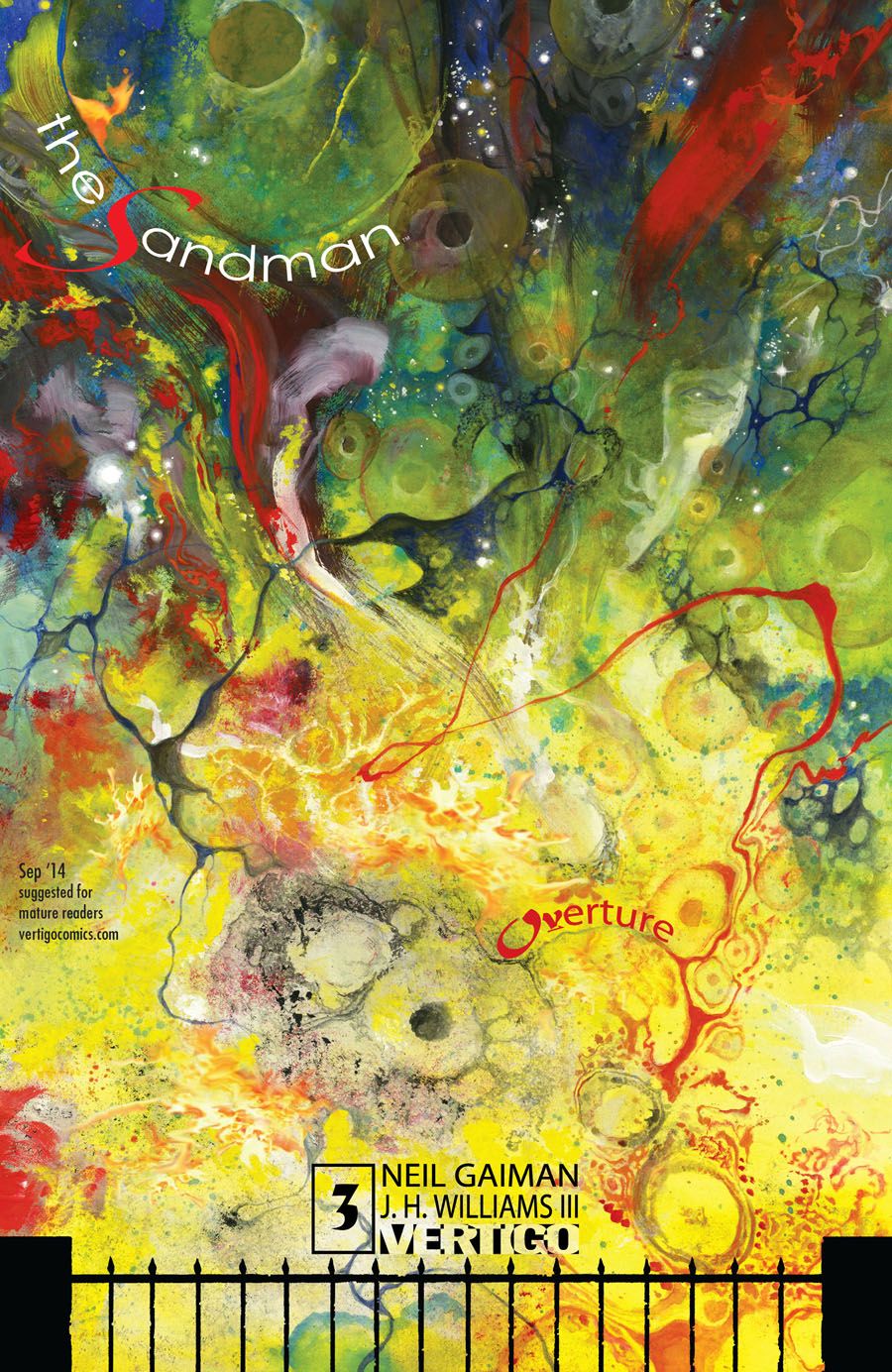It's been so long since we've had a trip into the world of Dream and company, it's easy to forget things that at the time we took for granted. "The Sandman: Overture" #3 by Neil Gaiman and J.H. Williams III reminds readers of some of those little gems; in this issue, it's not just great art or some beautiful narration, but also how well it handles surprise callbacks to earlier storylines.
"The Sandman: Overture" #3 continues to advance the plot of the first two issues, as the two Dreams move forward on their journey to confront the mad star. There's advancement on that front, explaining how a star can be more than just a big ball of gas burning in space, as well as encounters in this otherworldly realm that adds a new supporting cast member to the team that might not be as innocent as one might think. And taken strictly on that front, "The Sandman: Overture" #3 works well. Gaiman's descriptions of the different groups converging on the area are excellent -- they're both poetic and also telling just enough to let the art handle its half of the introduction -- and the inventiveness that one expects from Gaiman is quite evident from start to finish. (There's also a great nod to the fact that "The Sandman" is actually part of the DC Universe when it comes to the different forces mustering their presence, one that will tickle a lot of readers.)
But what makes "The Sandman: Overture" #3 work even better in terms of the writing is the way that older faces will integrate into the comic. Gaiman's usage of the three fates is a thread that has run throughout "The Sandman" and it's fun to see them showing up here as well. For a new reader, everything you need to know about them is on display in their three pages; you get a feel for their abilities and general demeanor, and quickly learn that while they can be helpful they are anything but kind or on anyone's side. For readers who have read "The Sandman," though, their presence has an extra ominous note about it. Knowing their presence in "The Kindly Ones" and what it ultimately means for Dream, their shadow casts a far larger darkness than one might otherwise feel.
Throughout "The Sandman: Overture" #3, there are little hints and pieces connected to earlier (or should that be later?) stories. A tale about a time that Dream's kingdom was under siege in the past gives us some surprising connections; not only with the origin of Dream's helm or the ornate bone gates that great those entering the Dreaming, but also the untold tale of an earlier lover of Dream who we saw once, ages ago. It meshes well with what we know about Dream and how his relationships always end; new readers understand more about Dream's personality, and older readers get a bonus Easter egg on a face that we previously could only speculate.
The writing is only half of "The Sandman: Overture" #3, though, and let it be clear: Williams and colorist Dave Stewart are knocking their half out of the proverbial park. Just look at the characters along the bottom-half of pages 4-5, as Williams channels his inner Jean "Moebius" Giraud. The closeups of Dream's face are just amazing; the lines around his eyes and down past his nose, the carefully pursed lips, the individual locks of hair with just a touch of curl. But in looking at the little details, you don't want to miss the larger, more spectacular moments. At the top of the page, the mesas in the distance remind of Williams' work on "Seven Soldiers" #0, as Williams both makes them look realistic and yet fantastical with the special rock formation on the fourth mesa. Stewart's colors here are gorgeous too, getting the strata that Williams drew having just the right tones running across them, their muted colors a contrast to the vivid foliage all around the two Dreams.
It's also not a Williams-drawn comic without some amazing page layouts. The triangles that separate the top and bottom half of pages 4-5 brings to mind the crafts that you'd find out in the western United States -- a perfect match for the scenery -- looking almost like a belt that wraps around the middle of the pages. (And all the while, still having a storytelling function by doubling as transition panels.) Turn the page, and the handprint formation of the panels is not only entrancing but also still tells the story tell. It's one thing to configure the panels of a page in a neat-looking way, it's something else to do so in a way that is easy to follow and communicates the information to the reader in an effective manner. Williams is a master of the latter.
From giants hanging onto the roots of the world, to armies of beetles, or a depressed being of light's panels being stripped of all colors, "The Sandman: Overture" #3 takes its storytelling needs quite seriously, without being strictly serious. This comic is full of flights of whimsy, dangerously grim moments and beautiful inventive set pieces. It's a real pleasure to read "The Sandman: Overture," and this issue is no exception. Once again, well done.

